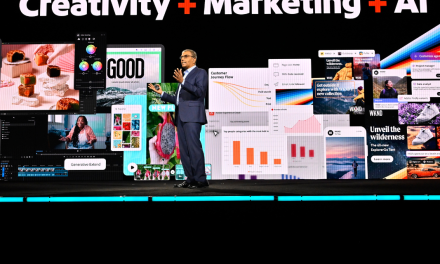A data driven approach enables organizations to remove assumptions about what they think their customers want and allows them to better anticipate their needs and expectations. With customer retention becoming more important, data driven marketing provides marketers with a way to better segment their audience, deliver a more personal customer experience and measure the performance of their campaigns more effectively.
In the same vein, data integration and management organization Talend recently held an Executive Exchange forum in Singapore with senior executives speaking on the theme of “Maximizing the Value of Data with A Modern Platform”.
MartechAsia was able to catch up with Muriel Raffatin, Talend’s Global Head of Marketing, to find out her views about the current data landscape in Asia and her thoughts on how organizations can plot a data-driven marketing strategy and leverage emerging, disruptive technologies, such as generative AI, to augment their marketing efforts.
How mature is APAC’s data landscape? How much are organisations using data-driven marketing in their decision making, brand building and business growth?
As with the rest of the world, organizations in the Asia Pacific region are accelerating initiatives in four focus areas. These are: modernization, cloud migration, establishing and/or improving data governance, as well as implementing an effective, organization-wide data culture.
In fact, IDC’s 2023 Worldwide Big Data Analytics (BDA) Spending Guide projects investments in the region to grow nearly 20 percent to USD42.2 billion this year. In particular, the report forecasts spending on enterprise intelligence solutions to continue growing from the previous year. This pattern is unsurprising due to the appetite to drive data-driven decision-making, enhance customer experiences, innovate faster and become more cost-effective and efficient.
The digitalization of behaviors has been a key changing factor for marketing organizations. In essence, we are seeing businesses make use of growing volumes of information they have about their customers, to plunge into data-based storytelling. Effectively, the growing emphasis on a 360-degree view of customers is being leveraged to channel trust by monitoring and measuring engagement, with the goal of gaining more actionable insights.
Organizations in the region are also striving to utilize data at its best, and strike the right chord with customers. In addition to improving customer relationships, this is also being used in more sophisticated ways to review processes and continually improve. Today, being a data driven marketing organization means deploying more efficient marketing strategies and measuring return of investment. For marketing organization, they see value on their data to as well demonstrate their own added value to their organization and justify additional investment

Are you seeing any significant hurdles to data utilization in APAC?
Leveraging the full potential of data is still a challenge and is impeding organizations’ efforts to be more data driven. The Talend Data Health Barometer found that 100 percent of Singapore respondents struggled with using data effectively, while 38% attested to difficulties with using data meaningfully to drive business impact.
Currently, organizations are lingering in a chaotic data environment, which proving to be unconducive to harnessing insights from growing volumes of data. For instance, our recent Barometer found that lacking confidence in decisions backed by company data, which indicates that many do not have a solid footing upon which to make critical decisions.
Unnecessary complexity and silos are adding to friction, which is then harming the organization’s ability to respond faster and with more agility to market conditions. There is also a lack of understanding about how to build an effective data strategy, with many opting for a piecemeal approach that only serves to create more bottlenecks.
Meanwhile, there is an acute talent and skills gap, which exacerbates difficulties in trying to be more data driven.
However, it isn’t all doom and gloom. Organizations can leverage low-code, modern data management tools to ensure workflows that establish and enforce data best practices that comply with external regulations, while also building a foundation of trusted data.
The data privacy regulation is a necessary framework for any organization in collecting data that requires an efficient data management process and a data governance implementation. Specially for a marketing organization, customers data is key but the collection and management must respect the regulation.
What frameworks should businesses look into and what is a good starting point for a business to get a data-driven marketing strategy going?
The first step to building an impactful data strategy is a thorough discovery process, which encompasses identifying how the organization’s data can help better serve customers and improve operations.
The key question to ask is what is the outcome expected. It should be the starting point of each data strategy. Specially for marketing: do we want to increase prospect outreach, do we want to measure marketing impact to the revenue, do we want to enhance customer experience.
A good data driven (marketing) strategy is a strategy that helps the organization to achieve a clear objective. It is the question I ask to my team; it is the question we ask to our customers. Then we can start designing the data strategy
Organizations can do this by leveraging the cloud’s scalability and flexibility to facilitate practical planning.
Next, organizations should assess the landscape and review best practices to drive objectives – both now and in the long run. This stage is intended to act as a means of understanding the technology stack and roadblocks to being more data driven. When the business value of each deployment is clearly understood, decision-makers can prioritize data storage and management methods, as well as vendors, that maximize business value.
Once this has been marked off the checklist, it’s time to lay out a forward-looking tactical roadmap for the organization’s data strategy. Typically, this will include specific projects that tie directly to business initiatives and an execution plan for each. As the first step to putting things into motion, organizations should think of the data strategy roadmap as a journey that includes the entire organization and all stakeholders.
The last step before launching the data strategy is to run pilot projects. These real-life crash tests optimize the benefits of the cloud, such as trial and error and more control over scale. Organizations, then, are empowered to build test use cases and iterate based on feedback.
With regulation tightening around data, how can marketers navigate the impact of how data is collected and used?
With growing concern around privacy, we are seeing regulators around the region push for improved compliance from businesses. Protections such as the GDPR and CCPA hold businesses to account for safeguarding customer data. While non-compliance fines are one thing, there is also the matter of losses in customer trust and confidence, which can ruin a business. Adding to the woes is the fact that the region is characterized by a highly complex regulatory landscape. Meanwhile, the phasing out of third-party cookies on Google Chrome puts the onus on businesses to provide best-in-class, country-specific first-party engagements.
However, this proverbial minefield can be navigated more successfully when businesses invest in tools that enable company data to be found, tracked and analyzed seamlessly. This ensures that data is accessible yet safe, mitigating the risk of data falling into the wrong hands. Not only is this a boost to the company’s data security, but it also ensures that those who don’t understand certain types of data are not saddled with it. As a result, organizations can significantly improve data experiences and decision-making. Meanwhile, IT leaders also gain better control over the quality and integrity of enterprise data, which fuels innovation.
We need to protect our customers, over the past years and in my marketing career, I think all these new rules have positively impacted the way marketers are engaging with their customers. We have set up a more win-win relationship with customers, getting their agreement to use their data give us a stronger responsibility on how we will use them.
In what ways can organizations leverage technologies, such as Generative AI in optimizing their marketing efforts? How can the manage the ethical issues and concerns over governance when using Generative AI?
While still in its infancy, Generative AI is already pushing the limits of innovation, and there seems to be enthusiasm for leveraging these benefits to drive unique, transformative customer experiences. In fact, KBV Research expects demand for Generative AI in Asia Pacific to grow 33.1 percent between 2022 and 2028.
However, while there is massive potential for further breakthroughs, the ethics of Generative AI need to be engaged with seriously, especially in terms of data culture and governance.
While there is no doubt that data quality and trusted data are critical to building near-real-time and predictive analytics, access, change and lineage are factors that are just as important. Therefore, Talend supports a data fabric and analytics framework that empowers our customers to strengthen governance and culture. By taking charge in framing data inventory, capture and cataloguing as mission-critical capabilities for both the private and public sector, Talend aims to position organizations to make full use of advancements like Generative AI, without compromising on ethics and compliance. As for each major, disruptive technological innovation, this should be considered as a new “tool” to better achieve the initial outcome expected. As other organization, marketing teams start thinking how they can use Generative AI to optimize their impact.


















